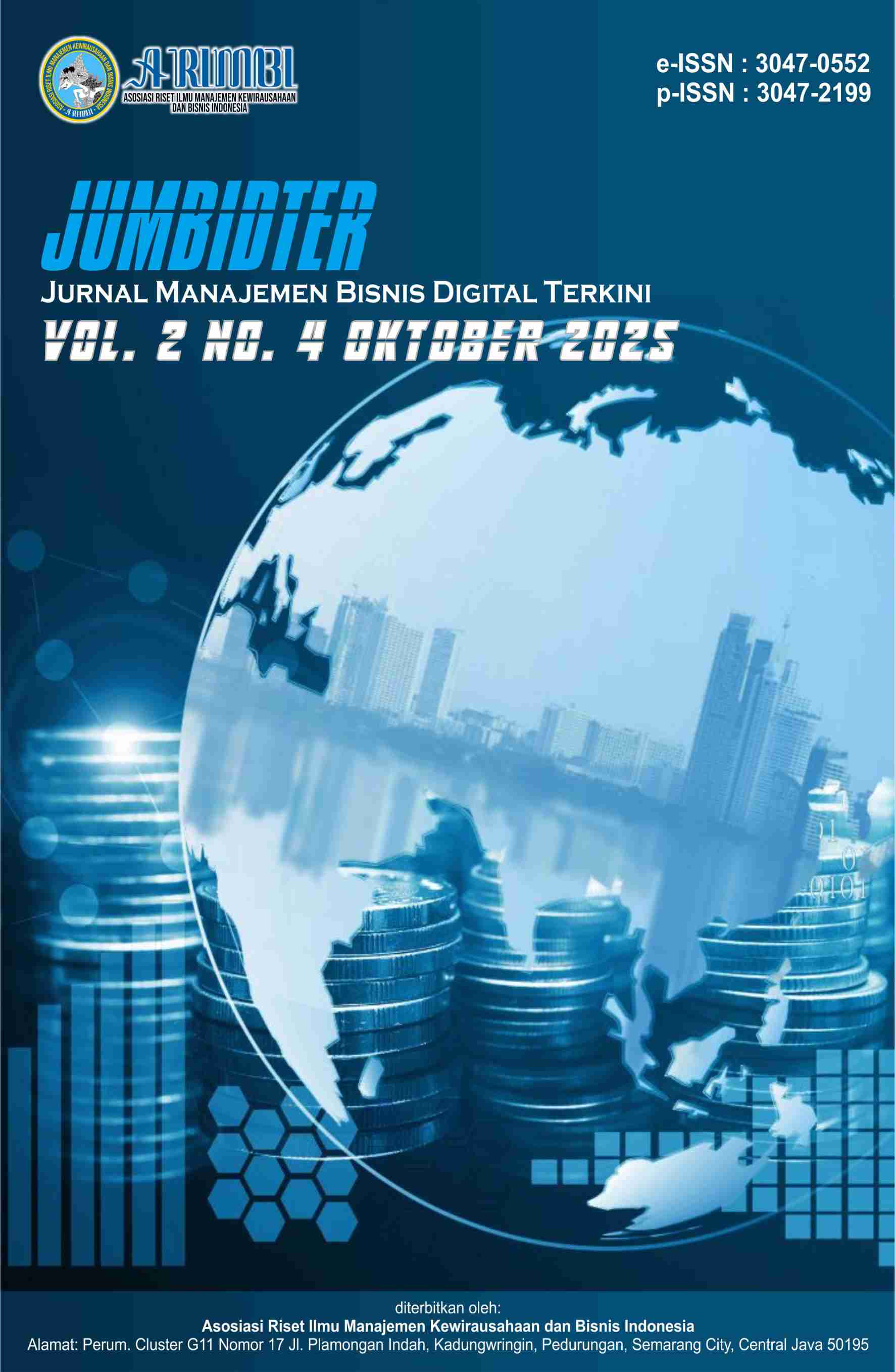Pengaruh Content Marketing dan Electronic Word Of Mouth (E-WOM) pada Media Sosial Tiktok Terhadap Keputusan Pembelian Produk Wardah
DOI:
https://doi.org/10.61132/jumbidter.v2i4.930Keywords:
Content Marketing, Electronic Word of Mouth, Purchase Decisions, TikTok, WardahAbstract
The development of digital technology has changed consumer interaction and behavior patterns, including in purchasing decisions. Social media, especially TikTok, has become a strategic platform in marketing due to its interactive and visual content-based nature. Wardah, as a local cosmetics brand, utilizes TikTok through content marketing and Electronic Word of Mouth (E-WOM) strategies to strengthen brand awareness and encourage purchasing interest. This study aims to analyze the influence of content marketing and E-WOM on TikTok social media on the decision to purchase Wardah products. The research method used is quantitative with an associative approach. The research sample consisted of 97 respondents determined through purposive sampling. Data analysis was conducted using validity and reliability tests, descriptive analysis, classical assumption tests, hypothesis testing, multiple linear regression analysis, and the coefficient of determination R2. The results showed that content marketing had a positive and significant effect on purchasing decisions (t-count = 2.188; sig. 0.031). E-WOM also has a positive and significant effect (t-count = 15.020; sig. 0.001), with a more dominant effect than content marketing. Simultaneously, both social media have a significant effect on purchasing decisions (F-count = 119.690; sig. 0.001). The coefficient of determination (R²) of 0.718 indicates that 71.8% of the variation in purchasing decisions can be explained by both social factors, while 28.2% is influenced by other social factors outside the scope of this study. These findings confirm the importance of digital marketing strategies based on creative content and consumer reviews in increasing purchasing decisions for Wardah products on TikTok.
Downloads
References
Ahmad, M. (2021). Pengaruh kelas sosial, keadaan ekonomi, dan kelompok acuan terhadap keputusan pembelian sepeda motor merek Honda Beat di Kota Sungai Penuh. Al-Dzahab, 2(2), 59–65. https://doi.org/10.32939/dhb.v2i2.941
Amruddin, Priyanda, R., Agustina, T. S., Ariantini, N. S., Rusmayani, N. G. A. L., Aslindar, D. A., Ningsih, K. P., Wulandari, S., Putranto, P., Yuniati, I., Untari, I., Mujiani, S., & Wicaksono, D. (2022). Metode penelitian kuantitatif (F. Sukmawati, Ed.; Vol. 4, No. 1). Pradina Pustaka.
Cici Ijan, M., & Ellyawati, J. (2023). The influence of content marketing and e-WOM on purchase decisions in TikTok social media. Research Inventy: International Journal of Engineering and Science, 13(7), 2319–6483. www.researchinventy.com
Erwin, S. E., Judijanto, L., Yuliasih, M., Nugroho, M. A., Amien, N. N., & Mauliansyah, F. (2024). Social media marketing trends. PT. Sonpedia Publishing Indonesia.
Field, A. (2013). Discovering statistics using SPSS (4th ed.). SAGE Publications.
Ghozali, I. (2021). Aplikasi analisis multivariate dengan program IBM SPSS 26. Badan Penerbit Universitas Diponegoro.
Iskandar, I., Faridatunnissa, D., & Wachjuni, W. (2023). Pengaruh lifestyle terhadap keputusan pembelian dengan content marketing sebagai variabel intervening. Prosiding, 6681(6), 620–630. https://prosidingfrima.digitechuniversity.ac.id/index.php/prosidingfrima/article/download/492/465
Koesharijadi, K., Merthayasa, A. A. A., & Nendi, I. (2022). Development of digital marketing strategy and service quality using social media towards digital economy. Journal of Social Science, 3(4), 799–804. https://doi.org/10.46799/jss.v3i4.375
Kotler, P., & Keller, L. K. (2016). Marketing management (15th ed.). Pearson Education.
Mayroza Wiska, F., Fenisi Resty, & Hidayatul Fitriani, H. F. (2022). Analisis content marketing dan electronic word of mouth (e-WOM) terhadap keputusan pembelian generasi Z pada media sosial TikTok (Studi kasus generasi Z Kabupaten Dharmasraya). Manajemen Dewantara, 6(2), 153–162. https://doi.org/10.26460/md.v6i2.12524
Oktaviani, D., & Haliza, N. (2023). Pengaruh review produk dan content marketing pada aplikasi TikTok terhadap keputusan pembelian generasi Z. Cakrawala Repositori IMWI, 6(4), 769–781. https://doi.org/10.52851/cakrawala.v6i4.416
Pranoto, I., Syamil, A., & dkk. (2023). Metodologi penelitian kuantitatif, kualitatif, dan kombinasi. Prenada Media.
Sayudin, S., Kartono, K., & Curatman, A. (2023). Increasing business effectiveness through the implementation of an integrated digital marketing strategy. Journal of World Science, 2(11), 1908–1913. https://doi.org/10.58344/jws.v2i11.478
Suarsa, S. H. (2020). Pengaruh electronic word of mouth (eWOM) pada online travel agent (OTA) Traveloka terhadap keputusan menginap di Topas Galeria Hotel, Bandung. Eqien: Jurnal Ekonomi dan Bisnis, 7(1), 50–56. https://doi.org/10.34308/eqien.v7i1.112
Sugiyono. (2019). Metode penelitian kuantitatif, kualitatif dan R&D. Alfabeta.
Wardhana, A. (2024). Social media marketing strategy-Edisi Indonesia. Eureka Media Aksara.
Wijaya, I. G. N. S., Pratami, N. W. C. A., Muryatini, N. N., & Yasa, G. D. (2022). Pengaruh electronic word of mouth (e-WOM), persepsi risiko, kepercayaan pelanggan, dan keputusan pembelian e-commerce Tokopedia. E-Jurnal Manajemen, 11(1), 190–209. https://ojs.unud.ac.id/index.php/manajemen/article/download/79786/43047
Downloads
Published
Issue
Section
License
Copyright (c) 2025 Jurnal Manajemen Bisnis Digital Terkini

This work is licensed under a Creative Commons Attribution-ShareAlike 4.0 International License.





